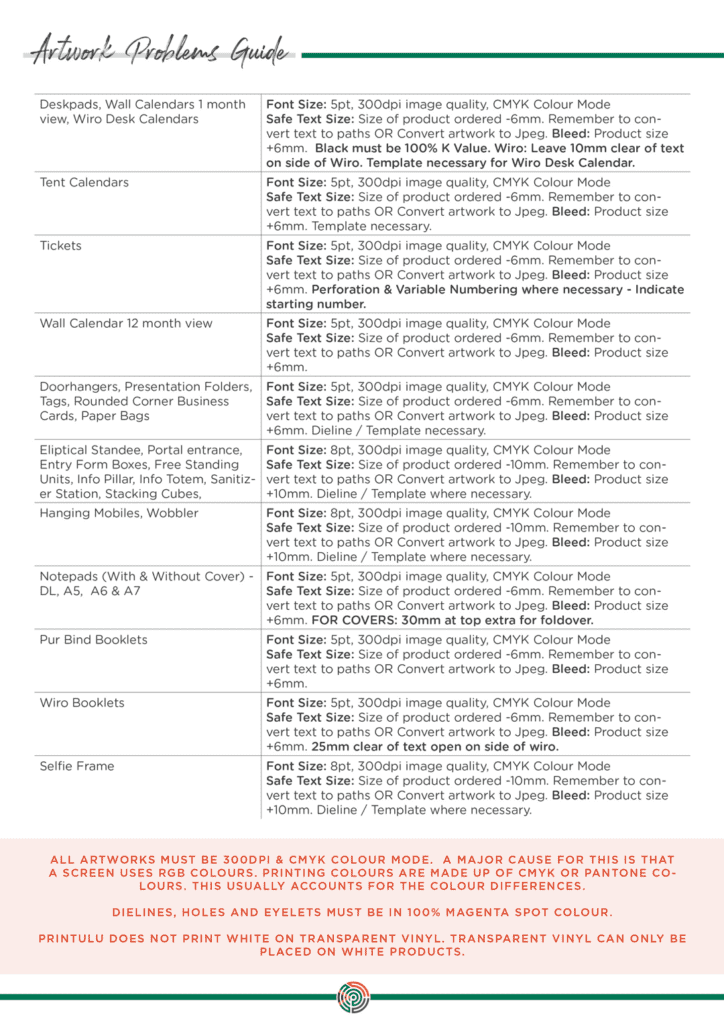When designing your printed product artwork follow our minimum requirements. Our artwork guidelines can help you to create print-ready artwork the first time around.
Design guidelines are sets of recommendations on how to apply design principles to provide a positive user experience. Some of the guidelines must be adhered to avoid common problems. Below is our guidelines & basic requirements cheat sheet. Please ensure that you meet the minimum requirements specified on these pages before submitting your artwork.
Artwork Specifications
When it comes to printing your artwork, there are some important specifications that you need to consider. These specifications ensure that your artwork looks great when it’s printed and avoids any unexpected surprises. So, let’s dive into the world of artwork guidelines for printing!

Printing Requirements
Printing requirements may seem like a complex topic, but don’t worry, we’ll break it down for you. By understanding these requirements, you can ensure that your artwork is ready for printing without any hiccups.
First and foremost, you need to consider the size of your artwork. The dimensions of your artwork should match the size at which you want it to be printed. You don’t want any awkward cropping or scaling issues, do you?
Next, the resolution of your artwork is crucial for high-quality printing. You should aim for a resolution of at least 300 DPI (dots per inch) to ensure crisp and clear prints. Anything lower than that might result in pixelated and blurry prints that nobody wants to see.
Another important requirement is choosing the right colour mode. For most printing purposes, CMYK is the way to go. CMYK stands for Cyan, Magenta, Yellow, and Key (Black), which are the primary colours used in printing. Using the CMYK colour mode ensures that your artwork appears vibrant and matches your expectations when printed.
Now, let’s not forget about bleed. Bleed refers to the extra area added to the edges of your artwork. It ensures that there are no white borders or incomplete designs after trimming. Typically, a bleed of 3mm is recommended, but it may vary depending on the print shop’s specifications. So, always check with the printing service provider before finalising your bleed.
Lastly, file formats play a significant role in artwork printing. The most commonly accepted file formats for printing are JPEG, TIFF, and PDF. These formats ensure that your artwork’s integrity is preserved during the printing process, resulting in high-quality prints.
Artwork Guidelines Formatting
Proper artwork formatting is vital for a successful printing experience. Here are some essential tips to nail your artwork formatting like a pro:
1. Keep it organized: Organize your artwork in layers and groups to make it easy to work with. It also helps prevent any accidental edits to the wrong elements.
2. Use appropriate fonts: When selecting fonts for your artwork, choose those that are easy to read and complement your design. Fancy fonts might look great on screen, but they can be challenging to print well.
3. Mind the margins: Ensure that important elements, like text or logos, are positioned well within the margins. Otherwise, they might get cut off during the printing or binding process.
4. Check for spelling and grammar: Triple-check your artwork for any spelling or grammar mistakes. You don’t want an embarrassing typo to make it into your final printed piece, right?
5. Test your colours: Don’t rely solely on your computer screen when it comes to colour choices. Differences in screen calibration can lead to varied results in print. So, it’s always a good idea to print a test copy to see how your colours turn out.
6. Be mindful of copyright: Ensure that you have the necessary rights or licenses for any images or elements used in your artwork. Printing copyrighted material without permission can lead to legal consequences.
7. Use high-quality images: Using low-resolution images can result in pixelated prints. Always use high-resolution images to ensure sharp and clear details in your artwork.
Remember, these guidelines are just the tip of the iceberg when it comes to artwork specifications for printing. Each printing service provider has specific requirements or suggestions, so make sure to reach out to them for any additional guidelines.
TECHNICAL ARTWORK GUIDELINES FOR PRINTING



